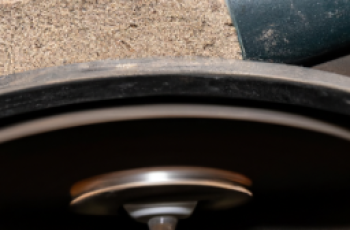Imagine having the power to control the speed of your die grinder with just a simple flick of a switch. With the innovative Die Grinder Speed Control, you can now effortlessly adjust the speed of your die grinder to fit your specific needs, making your grinding tasks smoother and more efficient than ever before. Whether you’re working on intricate detailing or heavy-duty grinding, this speed control feature ensures you have complete control over the intensity of your grinding, allowing you to achieve precise results every time. Say goodbye to guesswork and hello to ultimate precision with the Die Grinder Speed Control.

1. What is a die grinder?
a. Definition and purpose
A die grinder is a handheld power tool that is commonly used in metalworking, woodworking, and fabrication industries. It is designed to perform various tasks such as grinding, sanding, polishing, and shaping materials, making it an essential tool for professionals and DIY enthusiasts alike.
The main purpose of a die grinder is to remove material from a workpiece, either by abrasive cutting or grinding, which allows for precision work and a smooth finish. It is a versatile tool that can be used on different types of materials, including metal, wood, plastic, and ceramics.
b. Applications
Due to its versatility, die grinders can be used in a wide range of applications. Some common uses include:
-
Metalworking: Die grinders are widely used in metalworking applications such as weld seam preparation, rust removal, surface cleaning, and deburring. They can easily remove excess material and create smooth surfaces.
-
Woodworking: Die grinders are also useful in woodworking tasks such as shaping, sculpting, and routing wood. They can be used to create intricate designs and details on wooden projects.
-
Automotive: Die grinders are commonly used in automotive repair and maintenance jobs. They can be used to remove rust and paint, clean engine parts, and polish metal surfaces.
-
DIY projects: Die grinders are popular among DIY enthusiasts for various projects, including home improvement tasks, crafting, and hobbies. They offer precision and control, allowing users to achieve professional-looking results.
2. The importance of speed control
a. Precision work
One of the key reasons why speed control is essential in a die grinder is precision work. Different materials and applications require varying speeds to achieve the desired results. With speed control, you have the flexibility to adjust the RPM (revolutions per minute) of the tool to match the specific task at hand.
For intricate detailing and fine finishes, slower speeds are necessary. On the other hand, faster speeds are required for efficient material removal or when working on harder materials. Being able to control the speed allows you to achieve the level of precision required for your project.
b. Safety
Safety is of utmost importance when operating a die grinder. Working with high speeds and sharp attachments can be hazardous if not done with caution. Having speed control in a die grinder significantly improves safety by providing the operator with better control over the tool.
Slow speeds can be used for more delicate tasks, reducing the risk of accidental slips and potential injuries. Additionally, increased control over the tool’s speed allows the operator to avoid overheating the workpiece, another safety concern when using die grinders.
c. Versatility
A die grinder with speed control offers greater versatility in different applications. By being able to adjust the speed, you can use the same tool for various tasks and different materials. This eliminates the need for multiple tools, saving time, and increasing efficiency.
Whether you need to remove material quickly or work on delicate surfaces, the speed control feature allows you to adapt the die grinder to suit your specific needs. It ensures that you can achieve optimal results across a range of different projects.
3. Types of die grinders
a. Pneumatic die grinders
Pneumatic die grinders are powered by compressed air and are often referred to as air die grinders. They are lightweight, compact, and offer high-speed performance. These grinders are commonly used in industrial settings and require an air compressor for operation.
Pneumatic die grinders are preferred for tasks that require constant high-speed operation and in environments where electric tools may not be suitable, such as in wet or hazardous conditions. They are known for their durability and reliability, making them a popular choice among professionals.
b. Electric die grinders
Electric die grinders are powered by electricity and are generally more portable than their pneumatic counterparts. These grinders are versatile and can be used for a wide range of applications. They are available in corded and cordless models, offering flexibility in terms of mobility.
Electric die grinders are easier to maintain compared to pneumatic ones, as they do not require an air compressor. They provide consistent power output and are preferred for tasks that require variable speeds, making them an excellent choice for those who require precision control.
4. Speed control mechanisms
a. Variable speed control switches
Variable speed control switches are a common feature in die grinders. They allow the operator to adjust the speed by simply pressing and holding the switch. The pressure applied to the switch determines the speed of the grinder.
This mechanism provides easy control over the speed, allowing for smooth transitions from low to high speeds. It is a convenient and user-friendly feature, especially for those who frequently switch between different applications.
b. Speed control buttons
Some die grinders feature speed control buttons instead of switches. These buttons allow the operator to toggle between preset speed settings. Each button corresponds to a specific speed range, offering a quick and easy way to adjust the grinder’s speed.
Speed control buttons are useful when you frequently work on different materials or tasks that require varying speeds. They provide a clear indication of the speed range, ensuring that you can quickly select the appropriate setting.
c. Dial speed control
Die grinders with dial speed control feature a rotary dial that allows the operator to adjust the speed. This mechanism offers precise speed control as the dial can be turned to select the desired RPM directly. The speed adjustment is typically marked on the dial, making it easy to reference.
Dial speed control is advantageous when you require precise speed adjustments for specific applications. It allows for fine-tuning the speed to match the requirements of the task, ensuring optimal performance and results.
d. Electronic speed control
Electronic speed control is a more advanced feature available in some high-end die grinders. It utilizes electronic circuitry to maintain a constant speed regardless of load or pressure on the tool. This ensures consistent performance and prevents the grinder from slowing down when working on tougher materials.
Electronic speed control is particularly beneficial for tasks that require continuous operation at a set speed, as it eliminates the need for constant manual adjustments. It is a feature commonly found in professional-grade die grinders.

5. Advantages of die grinder speed control
a. Increased control and precision
One of the significant advantages of die grinder speed control is the increased control and precision it provides. Being able to adjust the speed allows you to work at a pace that suits the specific task and material. This precision control is crucial for achieving accurate results, especially when working on intricate or detailed projects.
b. Versatility in different applications
Die grinder speed control enhances the versatility of the tool. By having the ability to adjust the speed, you can use the same grinder for various applications and materials. This saves time and eliminates the need for multiple tools, making the die grinder a more efficient and versatile option.
Whether you need to remove material quickly or require a slower speed for fine finishing, die grinder speed control allows you to adapt the tool to suit your specific needs. It ensures that you can achieve optimal results across a range of different projects.
c. Maximized safety
Safety is paramount when using a die grinder, and speed control contributes significantly to ensuring safe operation. Being able to adjust the speed to slower settings increases safety by reducing the risk of accidental slips or mistakes. It allows the operator to have a better grip and control over the tool, minimizing the potential for accidents and injuries.
Additionally, speed control helps prevent overheating of the workpiece, which can pose safety risks, such as causing the material to warp or create sparks. By having precise control over the speed, you can avoid working at excessive speeds that may lead to overheating.
d. Extended tool life
Die grinder speed control also helps extend the life of the tool itself. By having control over the speed, you can adjust it to match the task at hand, preventing unnecessary wear and tear on the grinder. Running the tool at the appropriate speed for the material being worked on ensures optimal performance and longevity of the die grinder.
Working at excessively high speeds can put strain on the motor and other components of the tool, leading to premature wear and damage. With speed control, you can operate the grinder within the recommended speed range, maximizing its lifespan.
6. Factors to consider when choosing a die grinder with speed control
a. Power output
When selecting a die grinder with speed control, it is essential to consider the power output. The power output determines the tool’s ability to handle different tasks and materials effectively. Higher power output is generally preferred for tasks that require more abrasive cutting or grinding, while lower power output may be suitable for precision work.
Consider the specific applications you will be using the die grinder for and choose a power output that matches your needs. It is important to strike a balance between power and control to ensure optimal performance.
b. Ergonomics
Ergonomics play a crucial role in the comfort and usability of a die grinder, especially during prolonged use. Look for a die grinder that is designed with ergonomic features such as a comfortable grip, well-positioned speed control, and a lightweight body.
The tool should feel balanced and easy to maneuver, allowing you to work for extended periods without causing excessive strain on your hand or wrist. Comfortable ergonomics contribute to better control and overall user experience.
c. Durability
When investing in a die grinder, durability is an important factor to consider. Look for a die grinder that is made from high-quality materials and has a solid construction. The tool should be able to withstand regular use and any potential impacts or vibrations.
Check for features such as a robust motor, sturdy housing, and durable components. Ensuring that the die grinder is built to last will save you from frequent replacements and repairs in the long run.
d. Brand reputation
Choosing a die grinder from a reputable brand is always a wise decision. Established brands often have a track record of producing reliable and high-performing tools. They invest in research and development to ensure their products meet the needs and expectations of their customers.
Do some research, read reviews, and consider the reputation of the brand when selecting a die grinder. A trusted brand is more likely to provide good customer support and offer warranties or guarantees on their tools. This gives you peace of mind knowing that you are investing in a quality product.

7. How to use die grinder speed control effectively
a. Understanding the speed range
To use die grinder speed control effectively, it is important to understand the speed range of your specific tool. Different die grinders have different speed capabilities, and it is crucial to know the minimum and maximum speeds.
Refer to the user manual or the speed control markings on the tool to familiarize yourself with the speed range. This will help you select the appropriate speed for the task at hand, ensuring optimal performance and safety.
b. Practice and familiarity
Like any other tool, using a die grinder with speed control effectively requires practice and familiarity. Spend some time getting comfortable with the tool and its speed control mechanism. Practice on scrap materials or less critical projects to gain confidence and experience in adjusting the speed as needed.
Take note of the different applications and materials that require specific speeds. This will allow you to develop a better understanding of how to effectively utilize the speed control feature for different tasks.
c. Maintaining the right pressure
When using a die grinder with speed control, it is important to maintain the right pressure on the tool. Excessive pressure can cause the grinder to slow down, affecting performance, while too little pressure may result in the tool running at higher speeds than necessary.
Apply enough pressure to maintain contact between the grinding accessory and the workpiece, but avoid pressing too hard. Finding the right balance of pressure ensures optimal speed and performance, as well as consistent results.
8. Common issues and troubleshooting
a. Inconsistent speed
Sometimes, a die grinder’s speed control may become inconsistent, resulting in variations in speed during operation. This can be due to several factors, including dirt or debris clogging the speed control mechanism or worn-out speed control components.
To troubleshoot this issue, start by cleaning the speed control mechanism. Use a compressed air duster or a small brush to remove any dirt or debris that may be affecting the performance of the tool. If the problem persists, it may be necessary to have the speed control components inspected or replaced by a professional.
b. Overheating
Overheating can occur when operating a die grinder at excessively high speeds or for extended periods without breaks. This can lead to damage to the tool and potential safety hazards.
To avoid overheating, ensure that you are operating the die grinder within the recommended speed range for the specific task. Take breaks when necessary to allow the tool to cool down. Additionally, using appropriate lubrication on the tool can help reduce friction and prevent overheating.
c. Malfunctioning speed control
In rare cases, the speed control feature of a die grinder may malfunction, leading to an inability to adjust the speed. This could be due to internal electrical issues or a faulty speed control switch or button.
If you encounter a malfunctioning speed control, the best course of action is to contact the manufacturer or a professional tool repair service. They will be able to diagnose the problem and provide the necessary repairs or replacements.
9. Maintenance and care
a. Cleaning and lubrication
Proper cleaning and lubrication are essential for maintaining the performance and longevity of a die grinder with speed control. After each use, clean the tool to remove any debris or residue that may have accumulated. Use a brush or compressed air to clean hard-to-reach areas, and wipe the tool with a clean cloth.
Regularly lubricate the die grinder as per the manufacturer’s recommendations. Use a lubricant recommended for power tools and apply it to the appropriate parts, such as the bearings or gears. This will help reduce friction, prevent overheating, and prolong the life of the tool.
b. Checking for wear or damage
Regularly inspect the die grinder for any signs of wear or damage. Check the electrical cord or air hose for any cuts or frays, as these can be safety hazards. Inspect the grinding accessories for any signs of wear or damage, such as chips or uneven surfaces.
If you notice any wear or damage, replace the affected parts promptly. Continuing to use a damaged die grinder can compromise performance and safety.
c. Proper storage
When not in use, store the die grinder in a clean and dry place. Keep it away from moisture, dust, and extreme temperatures. Use the provided storage case or a suitable tool storage solution to protect the die grinder from any potential damage.
Ensure that the speed control is in the off position to prevent accidental activation when stored. This helps prolong the life of the speed control mechanism and ensures safe storage.
10. Conclusion
Die grinders with speed control are a valuable tool for professionals and DIY enthusiasts alike. With the ability to adjust the speed, these grinders offer increased control, precision, and safety. They are versatile and can be used in various applications, making them a must-have in any workshop or toolbox.
When choosing a die grinder with speed control, consider factors such as power output, ergonomics, durability, and brand reputation. Ensure that you understand the speed range of the tool and practice using it effectively.
Proper maintenance, such as cleaning, lubricating, and inspecting for wear or damage, will help prolong the life of the tool and ensure optimal performance. By following these guidelines and utilizing the speed control feature effectively, you can achieve professional-quality results and make the most out of your die grinder.



